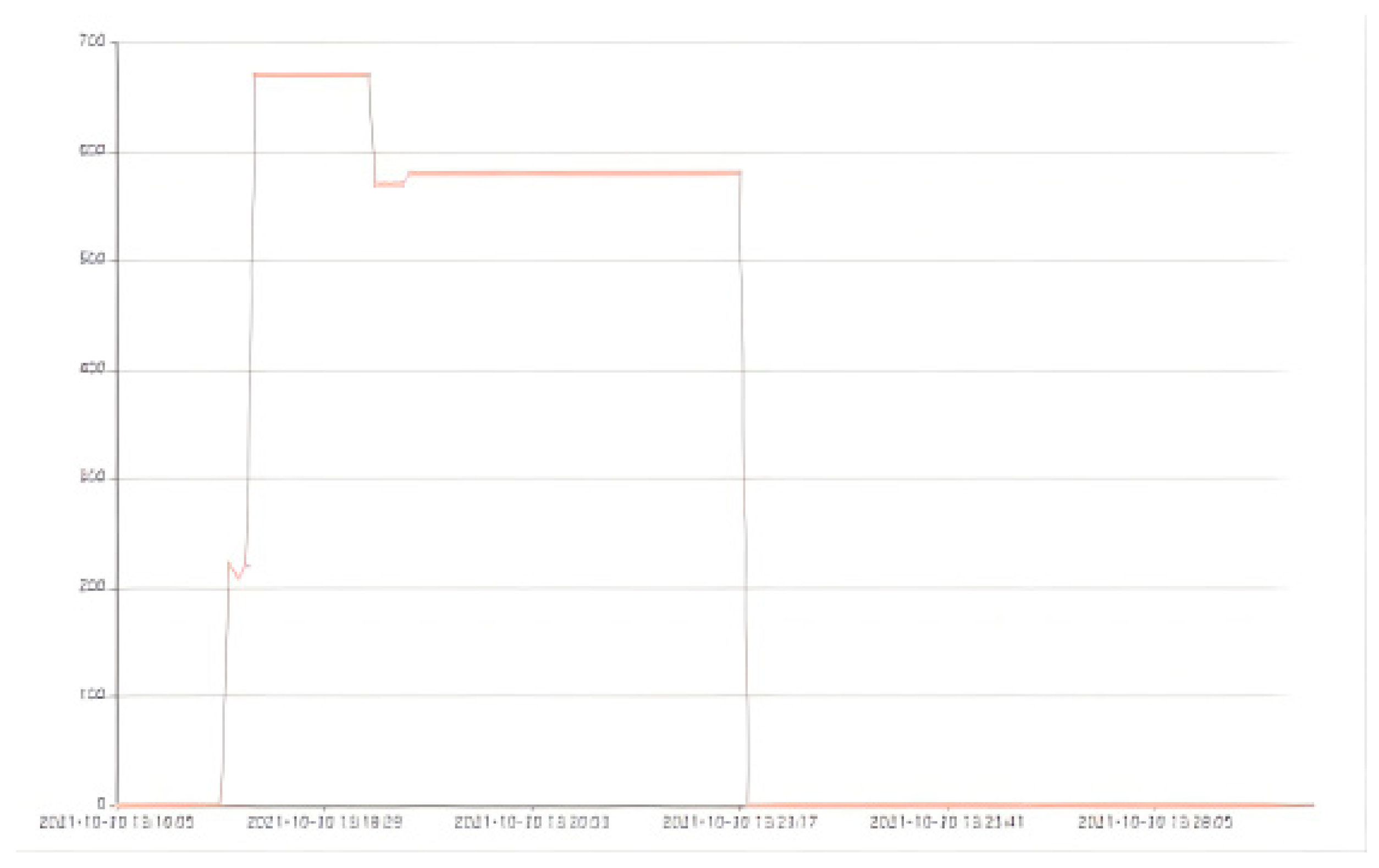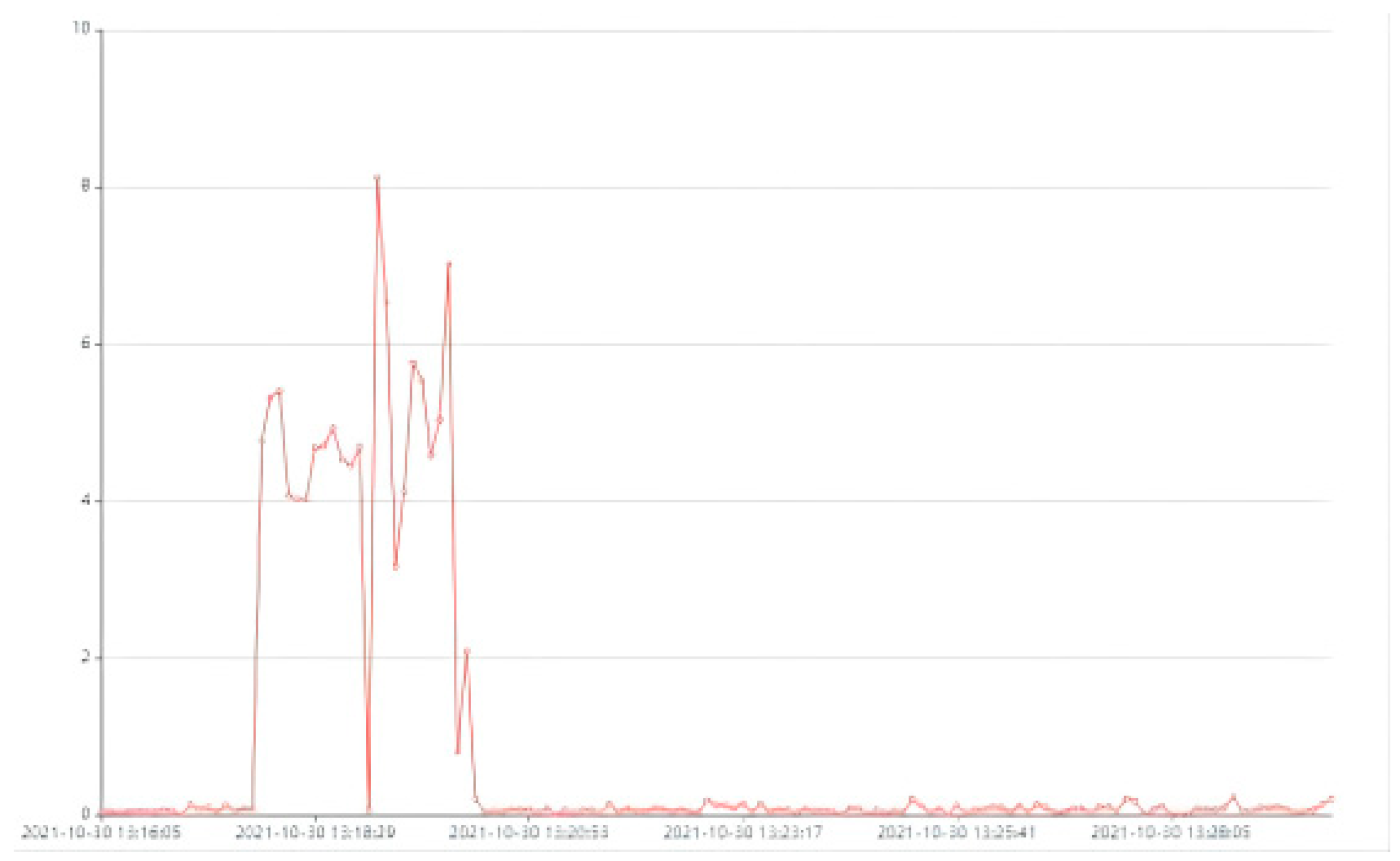Abstract
To meet the needs of remotely operating and maintaining combine harvesters in view of the problems of extensive operation, inefficient operation and maintenance, and backward management of combine harvesters, a remote operation and maintenance platform for the combine harvester has been designed. The platform mainly includes modules, such as data monitoring, fault prediction, fault diagnosis, and comprehensive operation maintenance. Among them, the data-monitoring module obtains the monitoring data of the vehicle terminal. It actively transmits to the remote operation and maintenance platform to remotely monitor the operation data or status of the combine harvester system. The fault prediction module builds a fault prediction model based on the fault features and data provided by all previous stages. It predicts and evaluates the actual operation of each component of the combine harvester in the foreseeable future, Based on the fault diagnosis model, the fault diagnosis module evaluates and classifies the current abnormal state of the combine harvester. The comprehensive operation and maintenance module formulates the corresponding maintenance and repair strategies according to the output results of the fault diagnosis and prediction. Through functional field testing of the platform, the results showed that the platform could perform real-time monitoring, fault prediction, fault diagnosis, and comprehensive operation maintenance for the operation information of the combine harvester. It helped to improve the intelligent operation level, management quality and operation, and maintenance efficiency of the combine harvester.
1. Introduction
As a major agricultural country, wheat, rice, and corn are also known as China’s three major staple crops. The planting area is very large. Mechanization of grain crops is the only way. It is also an important measure to increase farmers’ income, improve farmers’ quality of life, and build modern agriculture [1]. As the core technical equipment of the crop production process, the combine harvester is an important agricultural machinery equipment to realize the comprehensive, high quality and efficient development of the whole agricultural production. It plays a very important role in reducing the labor intensity of farmers, reducing production costs, and improving production efficiency [2]. At this stage, the mechanization of harvesting of staple crops in China has basically been realized. However, with the development of Chinese agricultural machinery production and the influence of the cross-regional “south and north war”, the demand for combine harvesters has gradually developed from small to medium and large. The combine harvester has a complex design and harsh working conditions. The state of the job object and the workload fluctuate greatly, and the failure rate is high. To keep abreast of the current health status of the combine harvester, it is urgent to monitor the working conditions and fault warnings of its key components. It can diagnose the state of the machine properly and find the machine fault in time to give an alarm [3,4]. In addition, the number of combine harvesters is large, and they are widely distributed. The effective remote operation and maintenance management of combine harvesters play an important role in improving machine efficiency and increasing the service life of each component. It is of great significance to promote the automation, intelligence, and modernization of combine harvesters in China and to realize agricultural modernization [5,6].
The equipment remote operation and maintenance technology use the Internet of Things, cloud technology, wireless communication [7], neural network, and other technologies to collect equipment operation data. It realizes the functions of fault diagnosis, fault prediction, component status assessment, and operation maintenance. It has become an important means of value-added services in the equipment manufacturing industry. The development of remote operation and maintenance technology is key to improving the application of equipment, especially for the complex operation equipment of combine harvesters. The research on the intelligent control, real-time positioning, and remote-monitoring technology of the combine harvester in foreign developed countries started earlier. The high degree of intelligence and automation of the combine harvester had been realized [8,9,10]. John Deere, the American company, developed the MyJohnDeere product and service platform. It was used to improve the efficiency and time of machine operation, logistics management, and agricultural decision-making, etc. It had the functions of online query of agricultural machinery operation position, statistical analysis of agricultural machinery operation data information, agricultural machinery operation efficiency calculation and operation cost accounting, etc. It realized the precise management of agricultural machinery operation [11,12]. CLAAS, the German company, applied the Trimble network smart farm system in agricultural production. It adopted wireless communication technology to realize the mutual communication between agricultural machinery and agricultural machinery and agricultural machinery and remote management center. This formed an agricultural Internet of Things system, which could efficiently manage agricultural machinery operations, agricultural machinery mobilization, etc. [13,14]. The intelligent cabs of the TUCANO series harvesters of the German CLASS Company and the 30 series harvesters of the Dutch Keith Company were equipped with electronic-monitoring display screens. It could display the working status of the harvester parts in real time and centrally control the harvester [15]. The British Massey Ferguson Harvester Company had developed a combine harvester farmland star system. It could detect the working failures of the combine harvester in time and issue an alarm prompt, which greatly reduced the failure rate of the combine harvester [16,17]. Japan’s Kubota Company designed an intelligent-monitoring device by integrating electronic-sensing technology, a display device, a positioning system, a geographic information system, and a remote-sensing measurement and control system. It was applied to the combine harvester, and the intelligent-monitoring function of the combine harvester during the harvesting process was realized [18]. In addition, Nataraj E S et al. developed a microcontroller-based embedded system with a digital display and audible warning units [19].
Domestic research started late. Most of the existing research [3,20,21,22,23] systems were aimed at single-vehicle operations. Among them, information collection, processing, and analysis were all completed by the vehicle terminal. For example, Chen Si of Jiangsu University had developed a remote video-monitoring and fault-monitoring system for combine harvesters. It used the WCDMA network as the wireless transmission network to realize the long-distance transmission of data. The fault solution was fed back to the airborne terminal through the remote-monitoring center to help the on-site staff in troubleshooting [24]. Li Bin et al. designed a remote-monitoring system based on GPS and GPRS. It could realize functions, such as data communication and analysis, data storage and query, real-time display of the position of the agricultural machinery, and track playback [25]. Peng Bo et al. developed a farm SMS center system integrating GPS positioning and wireless communication functions. This could solve the problems of low efficiency and poor timeliness of agricultural machinery operations in China. It could reasonably schedule agricultural machinery according to the actual production conditions of agricultural machinery [26]. The Institute of Remote Sensing of Peking University designed a set of agricultural-machinery-monitoring and management system. It realized the real-time operation monitoring of agricultural machinery, the collection of agricultural multi-source information, and the simple functions of agricultural machinery scheduling [27]. The Bei’an Administration Bureau designed and developed a set of agricultural machinery operation supervision management and service system. It was based on B/S network transmission for Heilongjiang Agricultural Reclamation Hongxing Farm [28,29]. Lovol Heavy Industry Co., Ltd. had built an IoT cloud service system for agricultural equipment, which realized functions, such as service fleet scheduling and remote diagnosis of agricultural machinery. It developed the “Zhi Nong Lovol” APP, which was convenient for users to obtain vehicle condition information, operation information, and fault information through smart phones in a timely manner [2]. The whole agricultural mechanization cloud service platform was developed by the China Academy of Agricultural Mechanization. It could realize the functions of agricultural machinery operation data monitoring, operation quality statistics, task scheduling, etc. It was suitable for various types of agricultural machinery and equipment, such as sowing, plant protection, and harvesting [30]. In summary, at present, domestic combine harvester operation monitoring, automatic driving, and other information technologies have been initially developed and applied. System functions are more focused on monitoring. However, due to the lack of remote operation and maintenance means, the application of operation and maintenance technology lags behind, especially in the research blank stage of fault diagnosis and operation maintenance. It cannot meet the requirements of high reliability operation of agricultural machinery. In addition, the remote operation and maintenance logic and configuration of the combine harvester are complex. The degree of automation is seriously insufficient. The maintenance and management are difficult and more challenging.
It is important to ensure that the combine harvester always works in the best state, maximizes production efficiency, and maintains a high quality of work. In view of the problems of extensive operation, inefficient operation and maintenance, and backward management of combine harvesters, this research plans to develop a remote operation and maintenance platform for combine harvesters. With the goal of “Internet + operation and maintenance services”, it can monitor the working status and fault warning of key components of the combine harvester. It establishes a system model of combine harvester operation and maintenance, decision-making, management, etc. It can properly adjust the machine state and detect machine failures to alarm in a timely manner. It carries out comprehensive maintenance work and formulates corresponding maintenance measures. It also maximizes machine efficiency and reduces unnecessary downtime. The platform helps improve the continuity and stability of the combine harvester operation. It promotes the development of the combine harvester operation and maintenance management in the direction of high efficiency, standardization, and remoteness.
2. Materials and Methods
2.1. Overall System Structure
The combine harvester remote operation and maintenance system is applied to the combine harvester, including vehicle terminal, remote transmission module, remote operation and maintenance platform, etc. Among them, the vehicle terminal is responsible for collecting the working condition information of the combine harvester through various sensors. After data preprocessing, it integrates according to the specified transmission format. Then, it sends the data to the remote transmission module through the serial port. The remote operation and maintenance platform can process working condition data, run fault diagnosis and prediction models, process user business logic data, etc. It also performs statistical analysis and displays it on the web interface in the form of charts and text. The schematic diagram of the overall structure of the remote operation and maintenance system of the combine harvester is shown in Figure 1.
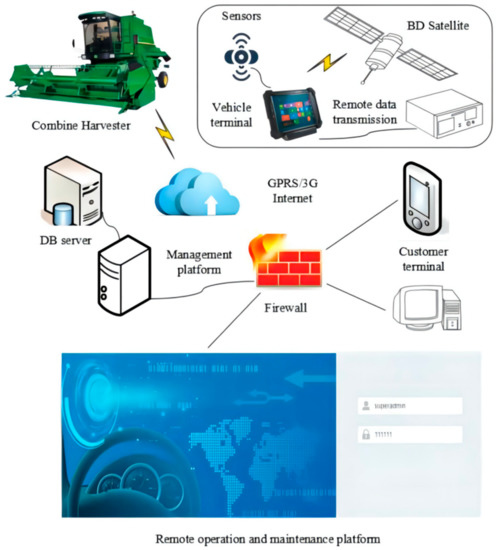
Figure 1.
Overall architecture of system.
2.2. Overall Platform Architecture and Functional Module Design
2.2.1. Overall Platform Architecture
The combine harvester remote operation and maintenance platform should be deployed on the cloud server. Facing the remote operation and maintenance service link of combine harvesters, the platform was based on the Zkoss architecture of the Web platform. It integrates big data, Internet of Things, Web GIS, and other technologies. It can perform real-time monitoring, fault prediction and diagnosis, and comprehensive operation maintenance of the operation information of the combine harvester. It further realizes the intelligent management and operation and maintenance of the combine harvester. The overall architecture of the combine harvester remote operation and maintenance platform is shown in Figure 2. According to the logical association, it is divided into front-end UI and display layer, business layer, data layer, database, and operating environment.
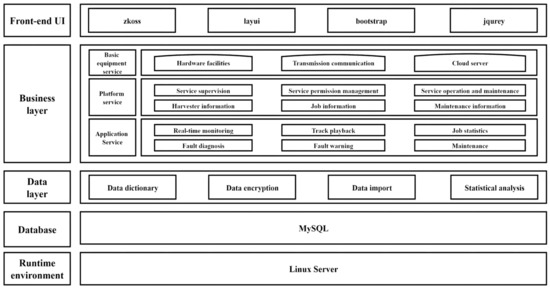
Figure 2.
Overall architecture of platform.
2.2.2. Platform Function Module Design
The combine harvester remote operation and maintenance platform mainly includes three modules: user management, operation management, and public services. The platform function module is shown in Figure 3. Among them, the user management module includes user authentication and application test, etc. It is convenient for users to register and log in. At the same time, it can effectively manage the application test process. The operation management module is the core of the platform, including data monitoring, fault prediction, fault diagnosis, and comprehensive operation maintenance. The public service module mainly performs functions, such as test data aggregation, export, statistical analysis, and report printing.

Figure 3.
Platform function block diagram.
- (1)
- Data monitoring
Data monitoring is the data support of the platform. The vehicle terminal obtains the monitoring data of the vehicle-monitoring sensor. It actively initiates a connection request to the platform server. It starts to send data remotely after the platform server confirms the request. The data is transmitted to the remote operation and maintenance platform. The platform remotely monitors the operation data or status of the combine harvester system.
- (2)
- Failure prediction
Failure prediction is an important function of the platform. Based on the data monitored by the platform, the failure characteristics and data provided by all previous stages are comprehensively utilized. Based on the neural network algorithm and the fault knowledge base, a fault prediction model is constructed. It can speculate and evaluate the actual operation and possible failure of each component of the combine harvester in the foreseeable future.
- (3)
- Fault diagnosis
Failure prediction is a key function of the platform. According to the data monitored by the platform based on the fault diagnosis model, the specific types and causes of the failure of the combine harvester are analyzed. It evaluates and classifies the current abnormal state of the combine harvester. It determines the cause and level of the failure of the combine harvester.
- (4)
- Comprehensive operation maintenance
Comprehensive job maintenance is the core function of the platform. Based on the operation safety and operation and maintenance cost of the combine harvester and according to the output results of the fault diagnosis and prediction combined with the spare parts management and operation and maintenance personnel management, the corresponding maintenance and repair strategies are formulated. It enables full-job maintenance.
2.3. Platform Development Key Technology
The platform is developed using Java technology. The frameworks used are Springboot, Mybatis, and Zkoss. The database is Mysql9. It adopts the B/S distributed network architecture. The web platform also uses the following key technologies:
- (1)
- Socket
The socket can make and answer network requests. It thus enables robust communication between the server and client programs. It is divided into three steps: ① server-side monitoring; ② client request; ③ connection confirmation [31]. In addition, it can use the socket network communication programming technology to realize the network communication between the vehicle terminal and the platform to carry out the data exchange of the multi-machine operation information.
- (2)
- Web-GIS
Web-GIS can use multiple hosts and multiple databases for distributed deployment. It is a browser/server (B/S) structure used to realize the interconnection through the Internet/Intranet. That is, the server provides information and services to the client; The browser (client) has the function of obtaining various spatial information and applications. The platform combines Baidu Map API with Web-GIS to embed Baidu Map into web pages. Combined with their own needs, the Web-GIS platform is developed, which is convenient for map publishing, data analysis, and application.
- (3)
- AJAX
AJAX is a web development technology for creating interactive web applications. The use of AJAX technology can enable web pages to be updated asynchronously and interact with the background database. In the case of not reloading the entire web page, the local area of the web page is refreshed, thereby enhancing the real-time performance of the platform.
2.4. Platform Function Realization
2.4.1. Data Monitoring
The combine harvester uses the on-board terminal to send job data to the platform. The platform uses the Netty framework to collect and process job data. It is stored in the Mysql database in a fixed format. When the user needs to view the job data of a certain combine harvester on the page, the front end sends the combine harvester ID to Kong through JavaScript Ajax. It is then transferred to the backend and then uses the ID to find the corresponding job data from the database and return it. Finally, the job data trend graph and machine job track are generated through the Echarts plug-in. The data flow of the Netty collection operation is shown in Figure 4. First, the client initiates a connection request. The selector under a NioEventLoop thread in the NIO thread, Boss Group, receives the request and establishes a connection. It then polls and listens for all IO request events. Then, it handles an IO request event to establish a connection and registers the SoketChannel to the selector. It prepares the Worker Group thread to process job data. Finally, the IO request event task queue is processed. The above process is repeated continuously. Among them, the job data uploaded by the client is processed by the selector under a NioEventLoop thread in the Worker Group thread. The data uploaded by the client is read and written.
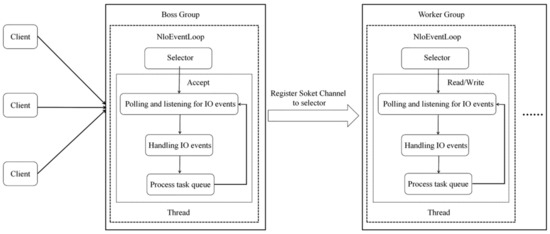
Figure 4.
Data monitoring flow chart.
2.4.2. Failure Prediction
Fault prediction is an important feature to distinguish intelligent operation and maintenance from traditional operation and maintenance. The fault features and data provided by all previous stages are comprehensively used to analyze, train, and determine the state based on the neural network [32]. In turn, it evaluates the health of the combine harvester and produces a fault diagnosis record. It determines the probability of failure to enable failure prediction of the combine harvesters. Fault prediction has successfully transformed the traditional operation and maintenance of “after the sheep” into a predictive and targeted guarantee operation and maintenance. It achieves the purpose of prolonging the life of the combine harvester. The failure prediction flowchart is shown in Figure 5.

Figure 5.
Failure prediction flowchart.
2.4.3. Fault Diagnosis
When the monitoring operation data is not within the specified threshold range, the platform will make necessary reminders for the specific fault location. It performs multi-dimensional analysis on attributes, such as platform application information, device status, and network conditions, and records fault information. It sets up the fields and storage space for the fault information property. After accumulating a certain amount of data in the early stage, if it is judged as a fault and as long as the situation is abnormal, the fault information is called according to the mapping relationship between the fault and the solution. If the fault cannot be found in the database, several possible faults are given, and the user is informed of the corresponding solution. In addition, the Echarts plug-in is also required here to visualize the type, location, and other information of the fault to the operation and maintenance personnel so that the operation and maintenance personnel can deal with the fault efficiently and quickly. The formation process of the fault knowledge base is shown in Figure 6.
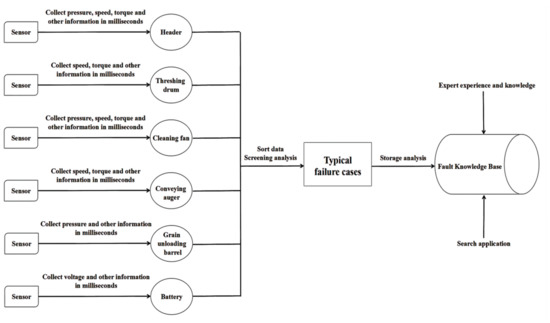
Figure 6.
Fault diagnosis flow chart.
2.4.4. Comprehensive Operation Maintenance
Comprehensive operation maintenance includes four parts: component operation record, maintenance work order, maintenance plan, and maintenance statistics. The component operation record shows whether each component has any abnormality during its operation. The maintenance work order records the maintenance of each component in detail. The maintenance plan is designed according to the characteristics and operating conditions of each component and is divided into preventive maintenance process (check and test the working conditions of the whole machine, key operating components, etc., and periodically reminds the operation and maintenance personnel to maintain the combine harvester), predictive maintenance process (after the prediction result is determined, the operation and maintenance platform should formulate a predictive maintenance plan for the combine harvester, realize the configuration of time, operation and maintenance personnel, and spare parts and automatically generate maintenance strategies and carry out maintenance activities), and fault repair process (call the fault knowledge base to make maintenance decisions and push maintenance methods). The maintenance process of the combine harvester is shown in Figure 7. The maintenance statistics record the maintenance status of each component in detail and compare it with the maintenance plan.
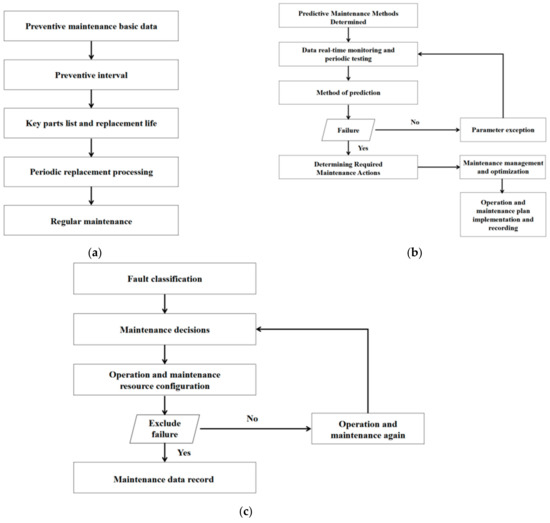
Figure 7.
Combine harvester maintenance process: (a) preventive maintenance; (b) predictive maintenance; (c) fault repair.
2.5. Platform Test
Platform testing consisted of two parts: writing test cases for platform stress testing and platform functional testing. The server configuration was: 2-core CPU, 16 GB RAM, CentOS 7.3 64-bit operating system, 5 Mb/s bandwidth, and 40 GB hard disk capacity. The string length of a TCP communication sent by the combine harvester vehicle terminal was 182.
2.5.1. Platform Stress Test
The for loop was used to open 2000 simulated vehicle terminals [33,34], and the new vehicle terminal initiated a connection request to the server and sent data. The transmission period, T, of each on-board terminal was 500 ms, and each on-board terminal was sent 1000 times. The connection count handler ( ) function was written to count the number of vehicle-mounted terminals connected to the server and the maximum statistical value within the simulation period (50 s) was recorded. A total of 20 trials were averaged.
2.5.2. Platform Function Test
The combine harvester on-board terminal was started, and the monitoring equipment was waited on to enter the normal working state, and the combine harvester was operated to start the normal harvesting operation (Figure 8a). The remote operation and maintenance platform was opened, the real-time data monitoring interface was entered, and the operation status information of the combine harvester was viewed (Figure 8b). Through the failure of the harvester that often occurred in actual work, the terminal uploaded the failure instruction to the cloud platform. Then the platform analyzed the instructions to diagnose the type of failure and maintenance method (Figure 8c). At the same time, whether the platform predicted the failure of the combine harvester was observed (Figure 8d). The final operation and maintenance platform called the fault knowledge base to make maintenance decisions and pushed the maintenance method to realize the maintenance of the machine operations (Figure 8e).
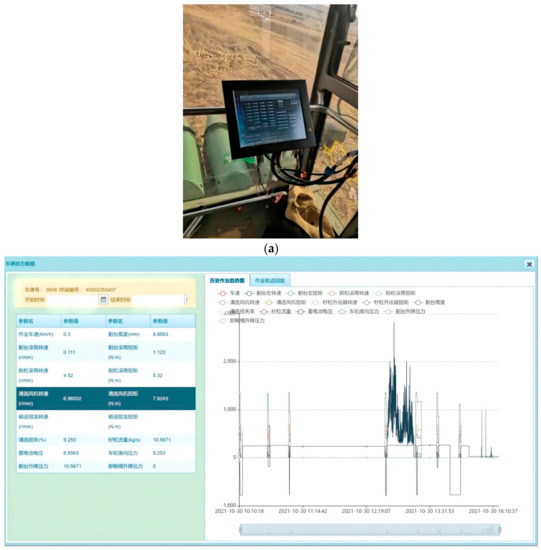
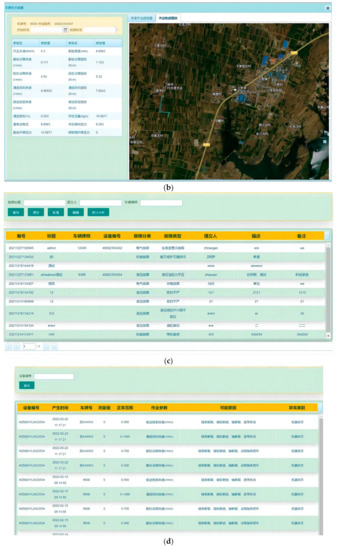

Figure 8.
Platform function test: (a) start combine harvester vehicle terminal; (b) data monitoring interface; (c) failure prediction interface; (d) fault diagnosis interface; (e) fault diagnosis interface; (f) job maintenance interface.
3. Results and Discussion
3.1. Platform Stress Test
The platform stress test results showed the maximum number of concurrent combine harvesters in the system based on the Netty framework and developed using the Java serialization codec method was 1853.
3.2. Platform Function Test
The platform could monitor the real-time machine operation information and display the machine operation trajectory. In the form of a table, the detailed historical working condition information of the terminal was displayed. The data changes of each monitoring point were displayed in the smallest granularity. When the server received the job data uploaded by the terminal device, it automatically analyzed the job data. It could automatically identify the abnormal operation status and automatically generate the fault diagnosis records. Subsequently, the administrator would comprehensively judge the real fault response of the working vehicle in combination with relevant information. The platform assigned relevant operation and maintenance personnel, arranged operation and maintenance personnel to repair the faulty vehicle, and recorded the repair results. The platform could realize the core functions of data monitoring, fault prediction, fault diagnosis, and comprehensive operation maintenance. This ensured that the combine harvester was always in the best condition, maximized production efficiency, and maintained a high quality of work.
To further verify the function of the combine harvester remote operation and maintenance platform, the test was carried out according to the above platform function test steps. In October 2021, the 4YL–5 model combine harvester produced by Wuzheng Group (Rizhao, China) was used as the test prototype to carry out the corn-crop-harvesting test. During the test, the transmission period of the vehicle terminal data was 400 ms, and the length of the data string was 182. According to the direction of the crop row, the harvesting test area was measured. The combine harvester was started, the hand throttle opening was set to an appropriate position, and the machine was operated to enter the rated harvesting state. The vehicle terminal software was started, and the “communication” indicator on the monitoring interface was waited on to light up. The “location” indicator on the monitoring interface was waited on to light up. The combine harvester was operated, which artificially createed faults, such as blockage of the header, breakage of the threshing drum transmission chain, damage to the battery, etc., to test the working performance of the remote operation and maintenance platform of the combine harvester. The test results are shown in Table 1, and the field test is shown in Figure 9.

Table 1.
Platform field performance test results.
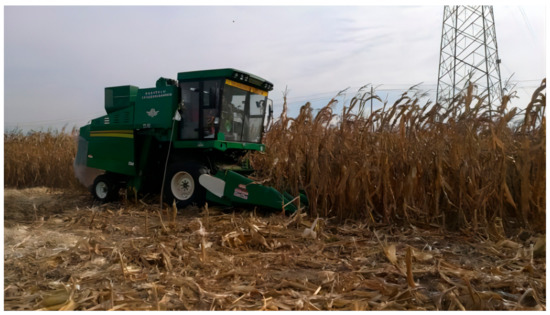
Figure 9.
Field test site.
From the analysis in Table 1, it could be seen that by artificially creating faults, such as blockage of the combine harvester header, breakage of the threshing drum drive chain, and battery damage, the platform remotely monitored the combine harvester header speed, threshing drum speed, battery voltage, and other parameters, through the vehicle-mounted terminal. The monitoring data had a sudden change, and the data was displayed as 0. According to the monitoring data of the speed of the header, the speed of the threshing drum and the voltage of the battery, the platform judged that failures, such as blockage of the header, blockage of the threshing drum, chain breakage, and battery damage, were about to occur. Then, based on the monitoring data of the above parameters, the platform judged the type of fault, the content of the fault, and the possible cause of the fault in combination with the actual work situation. Finally, the platform performed the corresponding operation maintenance according to the results of the fault prediction and fault diagnosis, and provided operation maintenance methods, maintenance methods, and fault handling measures to the workers or operators. In summary, the combine harvester remote operation and maintenance platform diagnosed the combine harvester operating state correctly, correctly output the corresponding abnormal state label, and gave specific operation and maintenance information. This further verified the reliability of the platform’s functions and helped improve the continuity and stability of the combine harvester’s operation.
4. Conclusions
(1) Based on the Zkoss architecture of the web platform and integrating technologies, such as big data, Internet of Things, and WebGIS, a remote operation and maintenance platform for combine harvesters had been developed. It mainly included three modules: user management, job management, and public services. Among them, the operation management module was the core of the platform, including data monitoring, fault prediction, fault diagnosis, and comprehensive operation maintenance. Through the core function test, it showed that the platform could realize real-time monitoring, fault prediction and diagnosis, and comprehensive operation maintenance of the combine harvester operation information.
(2) The for loop was used to open 2000 simulated in-vehicle terminals to stress test the platform. The maximum number of concurrent combine harvesters on the platform developed using the Java serialization codec method was 1853. This avoided the problem of slowing down the I/O speed when the amount of concurrency and data suddenly increased and enhanced the load-balancing capability of the platform.
(3) The performance of the platform was verified through the field test of the combine harvester, and faults, such as blockage of the header, breakage of the drive chain of the threshing drum, and damage to the battery, were artificially created. The platform correctly output the corresponding abnormal status label and provided operation and maintenance information, such as specific and corresponding operation maintenance methods, maintenance methods, and troubleshooting measures. This further showed that the platform helped to improve the intelligent operation level, management quality, and operation and maintenance efficiency of the combine harvester. It ensured that the combine harvester always worked at its best, maximized production efficiency, and maintained a consistently high quality of work.
The platform design is still in the experimental and initial trial stage. At present, platform operation and maintenance information could only be displayed in real time through on-board terminals and remote computers. There is a lack of in-depth user demand analysis. In the future, corresponding mobile APPs should be developed to serve more users. Due to the limitation of the number of collected parameters and the type of combine harvester, more types of fault models cannot be established. More parameters will be collected later. For the monitoring of working conditions, the common faults of various combine harvesters will be studied extensively. On the premise of the realization of online monitoring of sensors, the research on the parameter model of working conditions was carried out, and a reasonable warning threshold was selected.
The function of this platform focused on the monitoring and diagnosis of the operating state of the combine harvester. Its support function for field operations, such as combine harvester inspection and maintenance, was insufficient, and further research was needed. Due to the complex design of the combine harvester and the poor working conditions, some management functions are designed to be too simple. To better maximize the efficiency of combine harvesters, it is necessary to continue to improve functions and performance optimization and improve the level of informatization. In addition, the monitoring parameter data has a large amount of information. Follow-up studies, such as sampling frequency, transmission rate, and concurrency, need to be increased. The hardware configuration should be improved. The business function process design should be optimized to further reduce the pressure of the vehicle terminal on data processing and enhance the stability and reliability of the system. The dedicated network needs to be built by itself, which not only enhances the stability of the network, but also makes the system more economical.
Author Contributions
Conceptualization, Y.Y. and B.Z.; methodology, S.B., K.N. and L.Z.; software, Z.P. and Y.L.; validation, S.B. and F.W.; formal analysis, K.N. and S.B.; investigation, Z.L. and W.Z.; resources, Y.Y. and B.Z.; data curation, S.B.; writing—original draft preparation, S.B.; writing—review and editing, K.N. and L.L.; visualization, Z.P. and L.W.; supervision, Y.Y. and B.Z.; project administration, B.Z.; funding acquisition, Y.Y. and B.Z. All authors have read and agreed to the published version of the manuscript.
Funding
This work was mainly supported by the National Key Research and Development Program of China (Grant No. 2020YFB1709603) and the Intelligent Manufacturing Comprehensive Standardization Project (Grant No. 2018GXZ1101011).
Data Availability Statement
Data are contained within the article. The data presented in this study can be requested from the authors.
Conflicts of Interest
The authors declare no conflict of interest.
References
- Wang, H.B.; Yan, X.B.; Dai, Z.C.; Zhao, Y.K.; Du, P. Development Course and Trend of Combine Harvester in China. Tract. Farm Transp. 2021, 5, 10–12, (In Chinese with English abstract). [Google Scholar]
- Zhang, M.; Geng, A.J.; Zhang, Z.L.; Zhang, J. Research status and development trend of intelligence monitoring system for grain harvester. J. Chin. Agric. Mech. 2018, 9, 85–90, (In Chinese with English abstract). [Google Scholar] [CrossRef]
- Luo, X.W.; Liao, J.; Zou, X.J.; Zhang, Z.G.; Zhou, Z.Y.; Zang, Y.; Hu, L. Enhancing agricultural mechanization level through information technology. Trans. CSAE 2016, 20, 1–14, (In Chinese with English abstract). [Google Scholar]
- Chen, J.; Lv, S.J.; Li, Y.M.; Zheng, S.Y. Fault diagnosis of combine harvester based on PLC. Trans. Chin. Soc. Agric. Mach. 2011, 42, 112–116, 121, (In Chinese with English abstract). [Google Scholar]
- Yi, L.D. Research on Jam Fault Monitoring System for Combine Harvester; Jiangsu University: Zhenjiang, China, 2010; (In Chinese with English abstract). [Google Scholar]
- Yang, J.; Huang, Z.H.; Zhang, X.B.; Reardon, T. The rapid rise of cross-regional agricultural mechanization services in China. Am. J. Agric. Econ. 2013, 5, 1245–1251. [Google Scholar] [CrossRef]
- Hensh, S.; Tewari, V.K.; Upadhyay, G. A novel wireless instrumentation system for measurement of PTO (power take-off) torque requirement during rotary tillage. Biosyst. Eng. 2021, 212, 241–251. [Google Scholar] [CrossRef]
- Wang, L.F. Design and Development of Information Processing System in Harvester Based-on ARM; Harbin Institute of Technology: Shenzhen, China, 2013; (In Chinese with English abstract). [Google Scholar]
- Petre, L.M.; Heinz, D.K. Modeling and simulation of grain threshing and separation in threshing uints. Comput. Electron. Agric. 2008, 1, 96–104. [Google Scholar]
- Geert, C.; Wouter, S.; Bart, M.; Josse, D.B. A genetic input selection metho dology for identification of the cleaning procession a combine harvester. Biosyst. Eng. 2007, 1, 166–175. [Google Scholar]
- Jauyxb74. RDA Value Guide-Cross Implement. Available online: http://www.docin.com/p-1874367711.html (accessed on 22 March 2017).
- Kubba, A.E.; Jiang, K. Efficiency Enhancement of a Cantilever-Based Vibration Energy Harvester. Sensors 2014, 1, 188–211. [Google Scholar] [CrossRef] [PubMed] [Green Version]
- Mohapatra, G.; Mishra, R.; Sahay, S.S. Integrated Computational Materials Engineering: Extending from Design to Supply Management. Trans. Indian Inst. Met. 2019, 72, 2187. [Google Scholar] [CrossRef]
- Coen, T.; Saeys, W.; Missotten, B.; Baerdenarker, D.J. Cruise control on a combine harvester using model-based predictive control. Biosyst. Eng. 2008, 1, 47–55. [Google Scholar] [CrossRef]
- Xia, L.Q.; Liang, X.X.; Wei, L.G.; Zhao, B. Research progress of automatic monitoring system for combine harvesters. Farm Mach. 2013, 19, 141–144, (In Chinese with English abstract). [Google Scholar]
- Baruah, D.C.; Paneaser, B.S. Energy requirement model for a combine harvester. Biosystern Eng. 2005, 1, 9–25. [Google Scholar] [CrossRef]
- Gao, F. Research on Monitoring Device of Main Working Parts of Combine Harvester; Zhejiang University: Hangzhou, China, 2012; (In Chinese with English abstract). [Google Scholar]
- He, L.P. Fault Diagnosis and Analysis of Hydraulic System of Combine Harvester; Jiangsu University: Zhenjiang, China, 2010; (In Chinese with English abstract). [Google Scholar]
- Nataraj, E.; Sarkar, P.; Raheman, H.; Upadhyay, G. Embedded digital display and warning system of velocity ratio and wheel slip for tractor operated active tillage implements. J. Terramechanics 2021, 97, 35–43. [Google Scholar] [CrossRef]
- Chen, J.; Yang, G.J.; Xu, K.; Chen, S. Design of remote monitoring system for combine harvester based on ARM. Electron. Sci. Technol. 2016, 131–135, 141, (In Chinese with English abstract). [Google Scholar]
- Chen, J.; Wang, X.L.; Wang, Y.F. Main components working condition monitoring system of union harvester based on Android mobile phone. Trans. Chin. Soc. Agric. Mach. 2016, S1, 203–207, (In Chinese with English abstract). [Google Scholar]
- Li, X.C.; Li, M.Z.; Wang, X.J.; Zheng, L.H.; Zhang, M.; Sun, M.Z.; Sun, H. Development and denoising test of grain combine with remote yield monitoring system. Trans. CSAE 2014, 2, 1–8, (In Chinese with English abstract). [Google Scholar]
- Ma, Z.Y.; Yu, C.S.; Yang, L.; Yang, G.Y. Remote operation data acquisition system of combine harvester based on LabVIEW. J. Chin. Agric. Mech. 2019, 2, 135–139, (In Chinese with English abstract). [Google Scholar]
- Chen, S. Research on Remote Video Surveillance and Fault Monitoring System of Combine Harvester; Jiangsu University: Zhenjiang, China, 2016; (In Chinese with English abstract). [Google Scholar]
- Li, B.; Liu, R.; Li, J.Q. Design of remote monitoring system for large agricultural machinery based on GPS/GPRS. Jiangsu Agric. Sci. 2014, 2, 349–352, (In Chinese with English abstract). [Google Scholar]
- Zhang, X.Y. Research on the Intelligent Terminal of the Remote Monitoring System of the Crawler Harvester. J. Agric. Mech. Res. 2017, 2, 176–180, (In Chinese with English abstract). [Google Scholar]
- Wang, H.P. Design and Realization of Agricultural Machinery Remote Supervision Service System Based on WebGIS; Capital Normal University: Beijing, China, 2014; (In Chinese with English abstract). [Google Scholar]
- Fu, W.Q. Research and demonstration of IoT technology for cluster operation and operation and maintenance services of modern agricultural machinery and equipment. China Sci. Technol. Achiev. 2016, 19, 22–23, (In Chinese with English abstract). [Google Scholar]
- Wei, H.C.; Tan, W.N. Symposium on Internet of Things Application of Modern Agricultural Machinery and Equipment Held. Agric. Mach. Qual. Superv. 2018, 2, 7, (In Chinese with English abstract). [Google Scholar]
- Agricultural mechanization cloud service platform. China Rural Sci. Technol. 2020, 4, 33–36, (In Chinese with English abstract).
- Cao, R.Y.; Li, S.C.; Wei, S.; Ji, Y.H.; Zhang, M.; Li, H. Remote Monitoring Platform for Multi-machine Cooperation Based on Web-GIS. Trans. Chin. Soc. Agric. Mach. 2017, 48 (Supp. 1), 52–57, (In Chinese with English abstract). [Google Scholar]
- Nie, G.J.; Li, Q.Z.; Hu, N.; Jiang, S.X.; Chen, B.Q. Fault Prediction of Combine-harvester Based on Hybrid Neural Network. Electron. Prod. Reliab. Environ. Test. 2021, 1, 57–62, (In Chinese with English abstract). [Google Scholar]
- Sha, E.H.M.; Jiang, W.W.; Dong, H.L.; Ma, Z.L.; Zhang, R.Y.; Chen, X.Z.; Zhuge, Q.F. Towards the design of emcient and consistent index structure with minimal write activities for Non-volatile memory. IEEE Trans. Comput. 2018, 3, 432–448. [Google Scholar] [CrossRef]
- Su, J. Research and Implementation of High Performance RPC Server Based on Netty; Nanjing University of Posts and Telecommunications: Nanjing, China, 2018; (In Chinese with English abstract). [Google Scholar]
Publisher’s Note: MDPI stays neutral with regard to jurisdictional claims in published maps and institutional affiliations. |
© 2022 by the authors. Licensee MDPI, Basel, Switzerland. This article is an open access article distributed under the terms and conditions of the Creative Commons Attribution (CC BY) license (https://creativecommons.org/licenses/by/4.0/).

